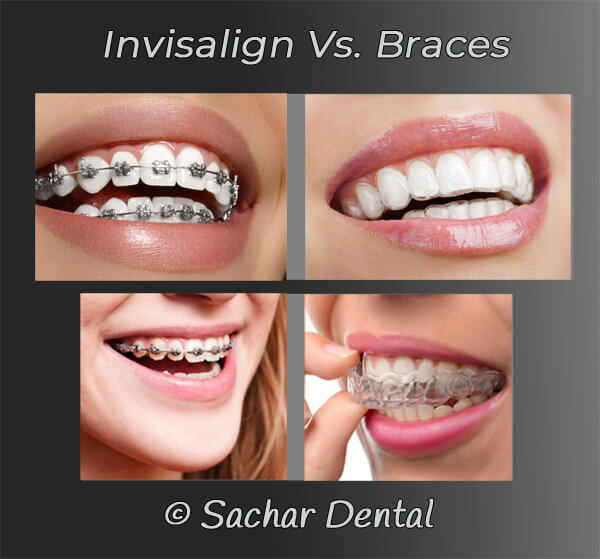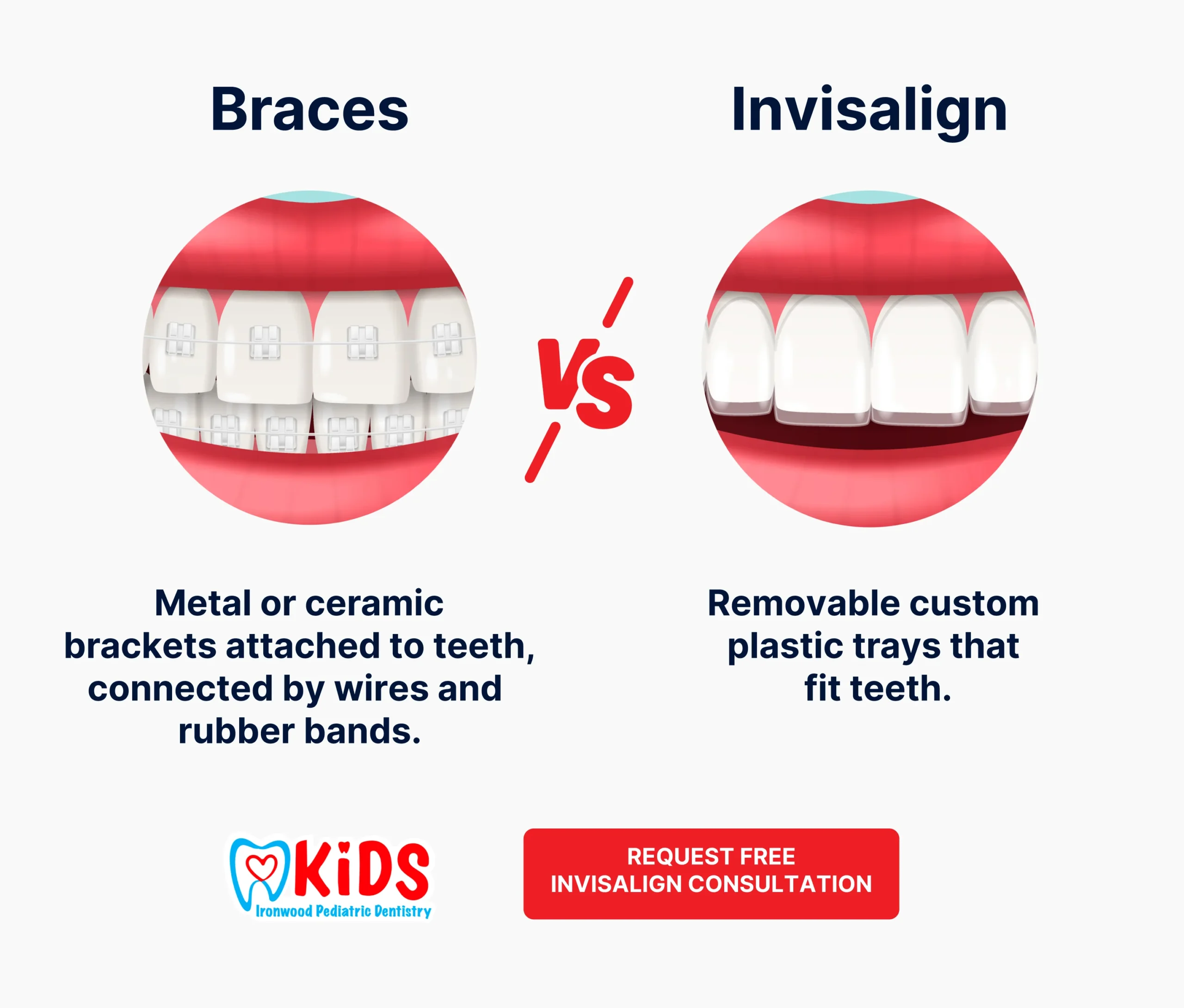Success Stories: How Invisalign Changed Lives and Boosted Confidence
Success Stories: How Invisalign Changed Lives and Boosted Confidence
Blog Article
Invisalign vs. Conventional Braces: Which Option Is Right for You?
When taking into consideration orthodontic therapy, the selection between Invisalign and conventional braces provides a number of important variables that warrant cautious analysis. Invisalign uses a very discreet choice with detachable aligners, while typical dental braces offer a much more visible yet effective solution for serious misalignment. Each alternative incorporates unique advantages and drawbacks connected to aesthetics, convenience, treatment duration, and cost. Understanding these nuances is essential for making an educated decision that straightens with your individual choices and way of life. The concern continues to be: which option will best satisfy your orthodontic needs and expectations?
Review of Treatment Options

On the other hand, conventional braces contain steel brackets and cables that are adhered to the teeth. This approach applies continual pressure in time to achieve positioning. While reliable for complicated orthodontic issues, typical dental braces need routine sees for adjustments and can present difficulties in maintaining dental hygiene as a result of the difficulty of cleaning around wires and braces.
Both alternatives have their benefits, and the selection commonly depends upon certain dental conditions, lifestyle choices, and patient conformity. Inevitably, seeking advice from an orthodontic expert is crucial for establishing one of the most suitable treatment plan tailored to individual needs. Comprehending the subtleties of each alternative can dramatically influence the total success of orthodontic therapy.
Visual Factors To Consider
A considerable variable influencing the selection in between Invisalign and conventional dental braces is the aesthetic allure each treatment provides. Invisalign aligners are crafted from clear plastic, making them virtually unnoticeable when put on. This discreet appearance is specifically interesting grownups and teenagers that may really feel self-conscious regarding their orthodontic treatment. The capacity to preserve an all-natural smile throughout the placement procedure can significantly improve the person's self-confidence in professional and social setups.
On the other hand, traditional dental braces include metal brackets and cords, which can be extra visible. While developments in orthodontic technology have actually caused the advancement of smaller sized braces and tinted elastics, standard braces still maintain an even more obvious account. For some individuals, the exposure of braces may hinder them from seeking required therapy.
Eventually, the option between Invisalign and standard braces may rest on individual choices regarding aesthetics. Clients that prioritize discretion typically favor Invisalign, while those that are less worried regarding visibility may go with typical dental braces. Understanding the aesthetic ramifications of each option is critical for making a notified decision that lines up with one's lifestyle and choices.
Comfort and Convenience

In terms of convenience, Invisalign aligners are removable, enabling individuals to enjoy their favorite foods without limitation and keep ideal oral hygiene. Cleaning and flossing are streamlined, as the aligners can be obtained throughout these routines, whereas standard braces need careful maneuvering around brackets and wires.
In comparison, standard braces necessitate routine changes, making them less convenient for those with hectic schedules. On the whole, the comfort and convenience of Invisalign make it an attractive choice for numerous people looking for orthodontic therapy.
Treatment Duration and Performance
While both Invisalign and standard dental braces work in correcting oral imbalances, the duration of treatment can differ considerably between both choices. Normally, Invisalign therapy can take anywhere from 12 to 18 months, relying on the complexity of the instance. The clear aligners function by progressively changing teeth right into their wanted positions, and routine follow-ups with an orthodontist assistance make certain progression continues to be on track.
In comparison, conventional braces typically need a longer commitment, typically varying from 18 months to three years. This read here is because of their fixed nature and using cords and braces, which can be more reliable for intricate instances and serious misalignments (Invisalign). The treatment performance of typical dental braces is well-documented, as they permit specific adjustments and better control over tooth movement
Ultimately, the selection between Invisalign and traditional braces may depend upon both the expected treatment period and the details dental issues handy. Consulting with an orthodontist is critical, as they can give customized suggestions based upon private demands, guaranteeing anchor the selected technique straightens with desired outcomes and timeframes.
Expense Comparison and Insurance Coverage Alternatives
Price plays a considerable role in the decision-making procedure for individuals considering orthodontic therapy, whether choosing Invisalign or standard dental braces. Typically, the cost of Invisalign ranges from $3,000 to $8,000, while typical braces generally cost in between $2,000 and $6,000. Variables affecting these prices include the intricacy of the instance, the duration of treatment, and geographical location.
Insurance policy protection can significantly influence out-of-pocket expenses. Many dental insurance policy strategies supply partial protection for orthodontic treatments, yet the specifics can vary extensively. It is important for individuals to evaluate their insurance coverage to determine the level of coverage for either option. Typically, traditional dental braces may be more often covered by insurance policy plans compared to Invisalign, which some insurers categorize as a cosmetic procedure.
Furthermore, numerous orthodontic techniques supply versatile layaway plan, making both treatment choices a lot more accessible. Clients ought to ask about prospective financing choices and discounts for ahead of time payments. Examining the complete expense, consisting of insurance policy advantages and settlement plans, is vital for making a notified decision that straightens with both visual preferences and budget factors to consider.

Final Thought
In recap, the selection in between Invisalign and her explanation standard dental braces depends upon multiple aspects, consisting of visual preferences, convenience, treatment duration, and price. Invisalign offers a very discreet, detachable alternative that promotes oral hygiene and dietary flexibility, while traditional dental braces might be preferable for intricate oral problems and frequently come with a reduced rate factor. Ultimately, consultation with an orthodontist is necessary to evaluate private scenarios and establish the most appropriate therapy alternative for accomplishing optimum oral alignment.
When thinking about orthodontic therapy, the selection between Invisalign and conventional braces provides several vital elements that warrant mindful assessment.Comparing Invisalign and conventional dental braces reveals unique therapy choices for orthodontic modification.While both Invisalign and conventional braces are effective in correcting oral imbalances, the period of treatment can vary dramatically in between the two alternatives.Cost plays a substantial duty in the decision-making procedure for individuals thinking about orthodontic treatment, whether choosing for Invisalign or conventional dental braces.In summary, the choice between Invisalign and standard braces hinges on multiple factors, consisting of aesthetic preferences, convenience, treatment period, and expense.
Report this page